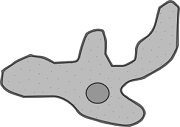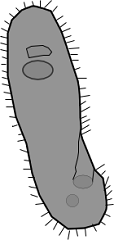 Protozoa
Protozoa

Organisms that are single celled, swim in water and consume food are generally called protozoa. They belong to the Kingdom Protista and are classified into different phyla based on how they move. If you take a drop of pond water and observe it under the microscope, you can often see tiny little organisms swimming around. In fact, Anton van Leeuwenhoek, one of the first scientists to observe these creatures under the microscope gave them the name “animalcules”, as if they were a combination of animals and molecules. Though protozoa may be tiny and unicellular, they have fascinating complexity.
Take for instance, the amoeba, which belongs to the Phylum Sarcodina. This single-celled protist can be any shape it wants because its membrane is flexible and it can push its cytoplasm around to change its shape. The word “amoeba” means “to change”. When you first look into the microscope for an amoeba, you may miss it because it does move slowly. It seems to take a lazy approach to life by casually stretching out its cytoplasm into extensions called pseudopodia. These extensions can also trap smaller protists within them, which create a food vacuole where the amoeba can digest them. In this case, slow doesn’t mean harmless – the smaller protists really don’t even sense the danger.
Another interesting protozoan is the paramecium. It moves using tiny hair-like structures on its surface called cilia. In fact, the paramecium belongs to a whole group of protists that move using cilia, the Phylum Ciliophora. Compared to the amoeba, the paramecium is fast swimmer. It is so fast that when looking for it under the microscope it may zoom right over your viewing field before you have a chance to really even see it. For this reason, biologists add a thickening agent to the water to slow the paramecium down so it can be seen more clearly. You can also place obstacles on the slide to get in its way, such as cotton fibers. Once you have the paramecium slowed or trapped, you can see many amazing features within it.
 The paramecium has two nuclei. One nucleus controls the cells activities, and the other functions in sexual reproduction. As the paramecium swims forward, it will roll its body so you can see both sides. On one side is an indentation called the oral groove. The paramecium sweeps food into this opening, which then forms a food vacuole within the cell where digestion occurs. Like the amoeba, paramecium generally eat protists that are smaller than they are. The oral groove is also used in sexual reproduction, where two paramecia join together and exchange DNA. Once they separate and divide by mitosis, the new paramecia are different from the original parent.
The paramecium has two nuclei. One nucleus controls the cells activities, and the other functions in sexual reproduction. As the paramecium swims forward, it will roll its body so you can see both sides. On one side is an indentation called the oral groove. The paramecium sweeps food into this opening, which then forms a food vacuole within the cell where digestion occurs. Like the amoeba, paramecium generally eat protists that are smaller than they are. The oral groove is also used in sexual reproduction, where two paramecia join together and exchange DNA. Once they separate and divide by mitosis, the new paramecia are different from the original parent.
Both the amoeba and the paramecium live in fresh water, and due to osmosis, water will tend to enter their cells. These two protists must have a strategy for removing the excess water (or they might explode!). The organelle called the contractile vacuole does the job. It serves as a water pump to remove the extra water that builds up in the cell. Under the microscope, the contractile vacuole will often look like a clear air bubble within the cell.
The amoeba and paramecium are just two of the many protozoa you can find living in pond water. There are other groups like the Zoomastigina phylum which include protists that move using a tail like structure called a flagella. The euglena has a flagella, but it is sometimes classified as an algae because it can photosynthesize – use light to create food like a plant.
There is even a group of protists that are parasitic and live within a host. Malaria is an illness caused by a protist that infects the blood through the bite of a mosquito. If a person is infected by malaria, they will suffer from chills and fever and overall weakness, and could even die. Generally, most protists are harmless and can be studied safely in a biology laboratory.
1. What organelle is used to remove excess water in protozoa?
a. food vacuole b. contractile vacuole c. nucleus
2. Which of these protists moves the fastest? a. amoeba b. paramecium
3. Where do the amoeba and the paramecium live? a. pond water b. sea water c. within the blood
4. The word “amoeba” means: a. to change b. unicellular c. slow mover
5. To what Kindgom and Phylum does the paramecium belong?
a. Protista, Sarcodina b. Protista, Ciliophora c. Ciliophora, Sarcodina
6. A pseudopodia is a(n ): a. row of cilia b. type of protist c. extension of the cytoplasm
7. Which is an illness caused by a protist: a. swine flu b. small pox c. malaria
8. Food is digested within: a. the oral groove b. food vacuoles c. the nucleus
9. Tiny hairlike structures located on the surface of the cell are called: a. cilia b. flagella c. pseudopodia
10. Which of the following is unicellular? a. amoeba b. paramecium c. both
11. Mitosis is a type of: a. movement b. cell division c. amoeba
12. Protozoa are grouped into different phyla based on:
a. their color and size b. how they move c. where they live
13. If you are studying a paramecium, what should you do to the slide?
a. heat it b. add cotton fibers c. turn it upside down
14. How does an amoeba catch its food?
a. by trapping it within its pseudopodia b. by sweeping food into its oral groove
15. The Blepharisma is protist related to the paramecium. It has cilia to help it move. How would you classify the blepharisma?
a. Phylum Sarcodina b. Phylum Zoomastigina c. Phylum Ciliophora

